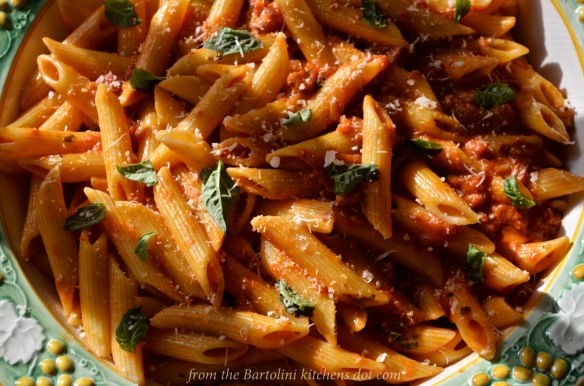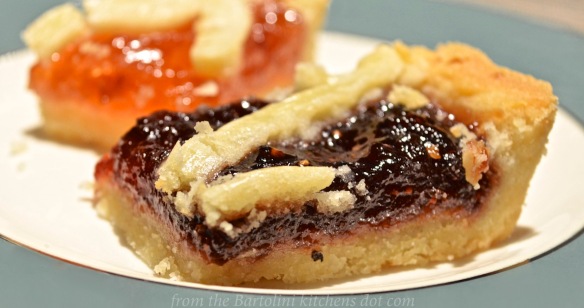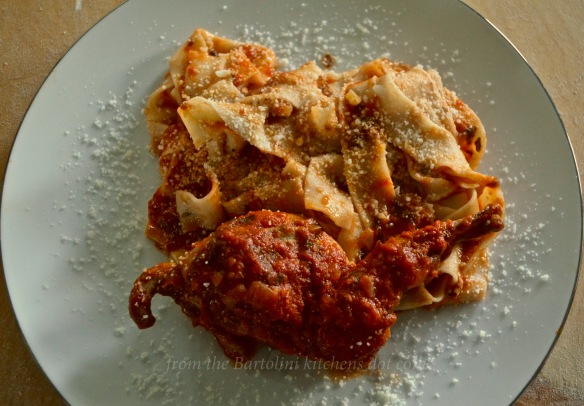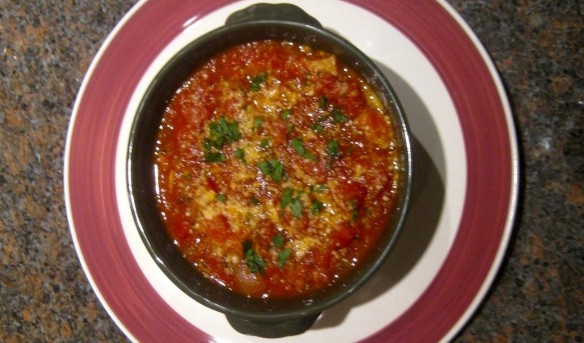 Now that’s a mouthful, isn’t it? I was talking about the title but the same applies to the dish. It’s one that I was served in Rome and I couldn’t wait to make it at home — but there was a problem. Although I’ve dressed pasta in this way, I didn’t own a chitarra, (guitar). No, I’ve not taken up an instrument during my time off.
Now that’s a mouthful, isn’t it? I was talking about the title but the same applies to the dish. It’s one that I was served in Rome and I couldn’t wait to make it at home — but there was a problem. Although I’ve dressed pasta in this way, I didn’t own a chitarra, (guitar). No, I’ve not taken up an instrument during my time off.
A chitarra is a piece of pasta making equipment that pre-dates the pasta machines common today. Abruzzo claims to be the instrument’s point of origin, believing it was developed there in the early 1800’s. A little larger than a shoe box, this chitarra has a number of strings evenly spaced on either side of a (removable) board. Each of the two sides creates a different pasta. Mine, for example, produces spaghetti and linguine. You place a dough strip on top of the strings and use a rolling-pin to score and form the pasta noodles. If they remain attached, a strum or two on the strings will cause them to fall to the board. Neat, huh? Unless, like me, you don’t own one.
When I went to Italy, I had a couple of things in mind to bring back home, one of which was a chitarra. Although I did see a couple in the first days of my trip, they didn’t make the type of pasta I wanted nor did they seem very durable, particularly considering that my “souvenir” would be stuffed into a suitcase. Remember the American Tourister adverts? These chitarre would never have survived the trip home, even though my bag was, coincidentally, an American Tourister. Unfortunately, I never saw a chitarra again — and it’s not for lack of looking. In fact, my last morning in Rome was spent going to housewares shops looking for the pasta maker. I finally gave up and, being near the Trevi Fountain, tossed in a few coins before treating myself to a peach gelato. Shopping is hard work, no matter the locale.
* * *

Didn’t find a chitarra but the morning wasn’t a complete loss. The Trevi Fountain was fed.
* * *
I probably would have let things end there but, as luck would have it, I was served today’s dish in Rome the night before and couldn’t get it out of my mind. The pasta was fantastic and I wanted a chitarra even more. So, when I returned home from Michigan, I went to my favorite online site for pasta equipment and bought myself a chitarra. Made on this side of the Atlantic, it’s a sturdy piece of equipment and, unlike those abroad, it can be sent back to be restrung when needed — for a price, of course. The chitarra was delivered within days and today’s dish is the result of our first duet. (By the way, if anyone asks, I bought my chitarra at a quaint little shop not far from our flat in Rome. Mum’s the word.)
* * *

Chitarra mio

Floured

Chitarra loaded

Strumming my chitarra

My chitarra’s notes

A symphony of pasta
Click to enlarge
* * *
Though originating in Amatrice in the 18th century, this sugo is based upon one that pre-dates the arrival of tomatoes from America to the Italian peninsula. (That dish, Spaghetti alla Gricia, is another I enjoyed while in Rome and will be sharing the recipe in the weeks to come.) It wasn’t long before the dish traveled to Rome, where it was quickly adopted and has become one of the Eternal City’s “classic” dishes. Today, Amatriciana is often used to dress bucatini, though not exclusively, as proven by my dinner that night. As you’ll soon see, it is one of the easiest tomato-based pasta sauces to prepare.
Sugo all’Amatriciana, in its purest form, consists of 3 ingredients: guanciale, tomatoes, and Pecorino Romano cheese. Depending upon the amount of fat rendered from the guanciale, a little extra virgin olive oil may be required. Add a little salt and pepper and your sugo is ready to go. As you might imagine, there are variations. The pasta I was served contained a hint of garlic and a little heat from red pepper flakes. Onions were not used and, according to my waiter, they rarely, if ever, are. So there you have it. If you’re using homemade pasta, this dinner can be on the table in well under 30 minutes. In fact, it will take longer for the pasta water to boil than for any other part of the dish to be prepared.
* * *

This is what I served
* * *
Spaghetti alla Chitarra all’Amatriciana Recipe
Ingredients
- spaghetti alla chitarra, not quite fully cooked — bucatini may be substituted
- 1 to 2 tbsp extra virgin olive oil
- 1 to 4 oz (28 to 112 g) guanciale, cut in lardons — pancetta may be substituted (See Notes)
- crushed red pepper flakes to taste (optional)
- 1 clove garlic, crushed (optional)
- cherry tomatoes, halved – quantity depends upon preference and servings prepared (See Notes)
- Pecorino Romano cheese
- salt and pepper
Directions
- Cook pasta in a large pot of salted water. (See Notes)
- Meanwhile, heat guanciale in a large frying pan over medium heat.
- When all the guanciale’s fat is just about rendered, add red pepper flakes and a crushed clove of garlic, if using. Add a little olive oil if the pan is too dry.
- When the garlic is golden brown, remove and discard it. By this point, the guanciale should be cooked but not “to a crisp”.
- The pasta should be nearing completion. Add the tomatoes to the frying pan. Raise the heat to med-high.
- Reserve a cup of the pasta water before draining the pasta.
- Add the pasta to the frying pan, stir and cook all the ingredients together until the pasta is cooked al dente. If too dry, add some of the pasta water to compensate.
- Turn off the heat, add a handful of grated Pecorino Romano cheese, and mix to combine. Add more pasta water if too dry.
- Serve immediately, garnished with more Pecorino Romano cheese and freshly cracked pepper.
* * *

This is what I was served
* * *
Notes
The most important issue when preparing pasta alla Amatriciana has to do with timing. If using freshly made pasta, as I did, the sugo will need to be almost fully cooked when the pasta is added to the water since the pasta will be ready in 2 to 3 minutes. If using store-bought or dried pasta, follow the package directions and drain the pasta when it is about 2 minutes shy of al dente.
Although guanciale is preferred, not everyone can find this Italian pork product. Pancetta may be substituted, as can non-smoked bacon. As much as I love smoked bacon, its smoky flavor would overpower the rest of this simple dish.
The dish I was served used halved cherry tomatoes. You could easily substitute one or two chopped fresh tomatoes, depending on the portions to be served.
* * *
Bella Firenze
(Click to enlarge any/all photos)

The City of Florence, West of the Arno River, as seen from the Piazzale di Michelangelo. On the left is the covered bridge, the Ponte Vecchio; in the center is the tower of the Palazzo Vecchio; further right are 2 domes, the smaller of which is the Basilica di San Lorenzo; and the remaining tower and dome belong to the Basilica di Santa Maria del Fiore, though known the World-over as Il Duomo.
* * *
My favorite city in the World, Florence was the birthplace and heart of the Italian Renaissance, while the city itself is a masterpiece. The basilicas that dot the landscape were each designed by the finest architects of the time. The art collections of the Uffizi Gallery — once the offices of the Medici family — are among the World’s finest, while the Piazza della Signoria is like no other. Walking its streets, you can feel the history and easily imagine you’re in the 15th century, hurrying to meet friends in front of the Baptistery of St. John. You don’t see Florence, you experience it.
I was the first to arrive at our flat, my friends were in transit from Sicily. This flat, too, had a terrace. To the South, we saw Il Duomo; to the North, San Lorenzo. Our days began and ended on that terrace.
 That there are so many large cathedrals in the Florence speaks volumes of its stature in Italy and all of Europe in the 15th and 16th centuries. Each, a thing of beauty in its own right, contains priceless works of art, not to mention the tombs of some very famous people. Above them all sits the Basilica di Santa Maria del Fiore, Il Duomo. Its external walls are made of 3 kinds of marble, each a different color — red, green, and white — and positioned in patterns composed of vertical and horizontal lines The cathedral’s magnificent dome was designed by famed architect, Brunelleschi. Just beyond its main entrance lies the Baptistery of St. John, the bronze doors of which, “The Gates of Paradise“, were designed by Ghiberti, The Basilica di San Lorenzo, also, features a dome designed
That there are so many large cathedrals in the Florence speaks volumes of its stature in Italy and all of Europe in the 15th and 16th centuries. Each, a thing of beauty in its own right, contains priceless works of art, not to mention the tombs of some very famous people. Above them all sits the Basilica di Santa Maria del Fiore, Il Duomo. Its external walls are made of 3 kinds of marble, each a different color — red, green, and white — and positioned in patterns composed of vertical and horizontal lines The cathedral’s magnificent dome was designed by famed architect, Brunelleschi. Just beyond its main entrance lies the Baptistery of St. John, the bronze doors of which, “The Gates of Paradise“, were designed by Ghiberti, The Basilica di San Lorenzo, also, features a dome designed by Brunelleschi though he died before its completion. This cathedral contains the tombs of members of the powerful Medici family. If it’s tombs you like, then you must visit the Basilica di Santa Croce. Within this beautiful cathedral’s walls you’ll find the tombs of Michelangelo, Galileo, and Machiavelli, to name a few. There are, also, funerary monuments for other famous Florentines, like Fermi and Dante.
by Brunelleschi though he died before its completion. This cathedral contains the tombs of members of the powerful Medici family. If it’s tombs you like, then you must visit the Basilica di Santa Croce. Within this beautiful cathedral’s walls you’ll find the tombs of Michelangelo, Galileo, and Machiavelli, to name a few. There are, also, funerary monuments for other famous Florentines, like Fermi and Dante.
Too dark for you? Is “high art” more your style? Then head to the Basilica di San Miniato al Monte. Located atop one of the highest points in Florence, it is perhaps the best example of Romanesque architecture in all of Tuscany. While you’re there, be sure to visit the Piazzale di Michelangelo which offers one of the most beautiful views of the city of Florence. (See photos above and below.)
Don’t feel much like climbing a hill? Then stroll over to the Church of San Marco where you’ll find frescoes by the Renaissance artist, Fra Angelico. The Church, though, is only the starter. For the main course, head next door to the monastery, where Fra Angelico, himself a monk, and his students decorated each monk’s cell with a beautiful fresco upon which he could reflect and meditate. It is an incredible collection of early Renaissance works by a true Master. All that’s left, then, is the dessert. For that, head down the street to the Galerie de l’Académie, where you’ll find Michelangelo’s massive statue, “David”. A more satisfying meal cannot be served and there is still so much more of Florence to savor. Get ready for your first taste.
* * *
Since I’ve spent so much time writing about cathedrals, I thought I’d share some photos of the Basilica of Santa Maria Novella, named “Novella”, New, because it was built upon the site of an earlier Church, Santa Maria delle Vigne. Completed in 1470, it is the first of the city’s great cathedrals to be built. In the center of the Cathedral hangs Giotto’s “Crucifix”, while its walls and side chapels, capelle, are decorated with frescoes created by some of the Renaissance’s most gifted artists. The sanctuary behind the awe-inspiring altar is called the Cappella Tornabuoni. The remarkably well-preserved frescoes decorating its walls were created by Ghirlandaio and his assistants, the most famous of which was a young Michelangelo.
(Though all photos are mine — like you couldn’t tell? –Wikipedia supplied some details and historical data.)
* * *

The Altar and Tornabuoni Chapel, Santa Maria Novella

Stained Glass within the Tornabuoni Chapel. designed by Ghirlandaio but produced by Agolanti.

Tornabuoni Chapel Frescoes Depicting Major Events in the Life of Mary

Giotto’s “Crucifix”

The Altarpiece of the Capella Stozzi
* * *
In and around Florence
* * *

Ponte Vecchio, as seen from the Uffizi

Shopping on the Ponte Vecchio

Replica of Michelangelo’s “David” in the Piazzele di Michelangelo

Rush hour

Greek & Roman statuary line a Uffizi Gallery corridor.
* * *

The City of Florence, East of the Arno River, as seen from the Piazzale di Michelangelo. To the left are remnants of the City’s walls with Galileo’s home just beyond the crest. If you look closely, you can see the dome of the Basilica of Santo Spirito, in the distance just to the left of the Arno River, beyond the Ponte Vecchio.
* * *
There’s more Florence yet to come.
* * *
It’s déjà vu all over again …
 Never mind our cool weather. It’s grilling season and here’s a way to cook fish on your barbecue without fear of the fillets sticking to the grates. Seasoned and enclosed in aluminum foil, you’d be hard-pressed to find an easier way to prepare fish. Oh! Did I mention how flavorful it is? Well, you can see three recipes for preparing fish in this way just by clicking HERE.
Never mind our cool weather. It’s grilling season and here’s a way to cook fish on your barbecue without fear of the fillets sticking to the grates. Seasoned and enclosed in aluminum foil, you’d be hard-pressed to find an easier way to prepare fish. Oh! Did I mention how flavorful it is? Well, you can see three recipes for preparing fish in this way just by clicking HERE.
* * *
Coming soon to a monitor near you …
 Pistachio Gelato
Pistachio Gelato
* * *
















































































